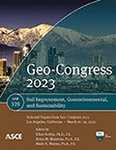Design and Life Cycle Assessment of Retaining Wall with Used Foundry Sand as Backfill
Publication: Geo-Congress 2023
ABSTRACT
This life cycle assessment analysis in the present study compares energy consumption, carbon footprint, and environmental damages for the retaining wall backfilled with natural sand and used foundry sand (UFS). Utilization of UFS contributes toward lowering environmental impact in terms of waste management, ecological sustainability, and monetary benefits. This study consists of two sections, i.e., retaining wall design for modified backfill parameters, followed by a life cycle analysis (LCA) comparison study. Index and engineering properties of natural sand and UFS are determined for the retaining wall design based on codal specifications. As the study is aimed at evaluating life cycle assessment for construction instances where alternate materials like UFS are utilized, production, transportation, and utilization of conventional construction materials have been taken into consideration, along with the disposal of waste materials. The impact of variation in the height and type of wall is also studied. Environmental impact categories such as cumulative energy demand, human toxicity, and resource and ecosystem impact are evaluated for the cradle-to-gate variant. The software tool openLCA is used for environmental impact studies where the Ecoinvent database is considered with a mid-point approach. Factors of safety against external and internal stability of walls for different cases are considered and found to be above permissible limits. The impact categories are significantly affected and depict a loss in values when the UFS mixture is used as a retaining wall backfill. This is because UFS introduction in sand reduces earth pressure leading to savings in natural sand, concrete quantity, reinforcing steel, and fuel quantity consumed by building machines and vehicles transporting construction materials. The study concludes that in all examined impact categories, an alternative material provides a significant environmental benefit than the conventional material without compromising stability. The results demonstrate that the use of UFS is very effective as a sustainable alternative to natural sand for the backfill of retaining structures.
Get full access to this article
View all available purchase options and get full access to this chapter.
REFERENCES
Sinha, A. K., Vinoth, M., Shankar, S. R., and Havanagi, V. G. H. (2020). Characterisation of Foundry Sand Waste Material for Road Construction. New Building Material & Construction World. https://www.nbmcw.com/article-report/infrastructure-construction/roads-and-pavements/characterisation-of-foundry-sand-waste-material-for-road-construction.html.
AASHTO. (2010). LRFD Bridge Design Specifications. https://search.library.wisc.edu/catalog/9910106658902121.
Arthur Casagrande. (1948). Classification and Identification of Soils. Transactions of the American Society of Civil Engineers, 113, 901–930.
ASTM. ASTM D854. (2002). Standard Test Methods for Specific Gravity of Soil Solids by Water Pycnometer. ASTM International, West Conshohocken, PA.
ASTM. ASTM D2434. (2019). Standard Test Method for Permeability of Granular Soils (Constant Head). ASTM International, West Conshohocken, PA.
ASTM. ASTM D2487. (2006). Classification and identification of soils for general engineering purposes. ASTM International, West Conshohocken, PA.
ASTM. ASTM D3080. (2004). Standard Test Method for Direct Shear Test of Soils Under Consolidated Drained Conditions. ASTM International, West Conshohocken, PA.
ASTM. ASTM D4254. (2000). Standard Test Methods for Minimum Index Density and Unit Weight of Soils and Calculation of Relative Density. ASTM International, West Conshohocken, PA.
FHWA (Federal Highway Adminstration). (2001). Mechanically Stabilized Earth Walls and Reinforced Soil Slopes Design & Construction Guidelines. Federal Highway Adminstration, Washington.
IRC (Indian Roads Congress). IRC:SP:102. (2014). Guidelines for design and constrcution of reinforced soil walls. Indian Roads Congress, New Delhi, India.
BIS (Bureau of Indian Standards). IS 456. (2000). Plain and reinforced concrete - Code of practice. Bureau of Indian Standards, New Delhi, India.
BIS (Bureau of Indian Standards). IS 14458. (1997). Guidelines for retaining wall for hilly area. Bureau of Indian Standards, New Delhi, India.
BIS (Bureau of Indian Standards). ISO 14040. (2006). Environmental Management - Life Cycle Assessment - Principles and Framework. Bureau of Indian Standards, New Delhi, India.
BIS (Bureau of Indian Standards). ISO 14044. (2006). Environmental Management-Life Cycle Assessment-Requirements and Guidelines. Bureau of Indian Standards, New Delhi, India.
Bowles, J. E. (1988). Foundation Analysis and Design. McGraw-Hill.
Kendall, A., Raymond, A. J., Tipton, J., and DeJong, J. T. (2018). Review of life-cycle-based environmental assessments of geotechnical systems. Proceedings of the Institution of Civil Engineers - Engineering Sustainability, 171(2), 57–67. https://doi.org/10.1680/jensu.16.00073.
Kumar, A., and Parihar, A. (2021). State-of-the-Art Review on Sustainability in Geotechnical Applications of Waste Foundry Sand. Indian Geotechnical Journal. https://doi.org/10.1007/s40098-021-00580-1.
Lee, K., Cho, J., Salgado, R., and Lee, I. (2001). Retaining Wall Model Test with Waste Foundry Sand Mixture Backfill. Geotechnical Testing Journal, 24(4), 401–408. https://doi.org/10.1520/GTJ11137J.
Samuelsson, I., Larsson, S., and Spross, J. (2021). Life cycle assessment and life cycle cost analysis for geotechnical engineering: Review and research gaps. IOP Conference Series: Earth and Environmental Science, 710(1). https://doi.org/10.1088/1755-1315/710/1/012031.
Song, X., Carlsson, C., Kiilsgaard, R., Bendz, D., and Kennedy, H. (2020). Life Cycle Assessment of Geotechnical Works in Building Construction: A Review and Recommendations. Sustainability, 12(20), 8442. https://doi.org/10.3390/su12208442.
UN Environment and the International Energy Agency. (2017). Global Status Report. https://www.worldgbc.org/news-media/global-status-report-2017.
U.S. Green Building Council. (2021). Top 10 Countries and Regions for LEED. https://www.usgbc.org/articles/usgbc-announces-top-10-countries-and-regions-leed-2021.
Vieira, C. S. (2022). Sustainability in Geotechnics through the Use of Environmentally Friendly Materials. In Sustainability (Vol. 14, Issue 3). MDPI. https://doi.org/10.3390/su14031155.
WisDOT (Wisconsin Department of Transportation). (2015). Bridge Manual Chapter 14 Retaining walls. Wisconsin Department of Transportation.
World Green Building Council. (2019). New report: The building and construction sector can reach net zero carbon emissions by 2050. https://www.worldgbc.org/news-media/WorldGBC-embodied-carbon-report-published.
Information & Authors
Information
Published In
History
Published online: Mar 23, 2023
Authors
Metrics & Citations
Metrics
Citations
Download citation
If you have the appropriate software installed, you can download article citation data to the citation manager of your choice. Simply select your manager software from the list below and click Download.
